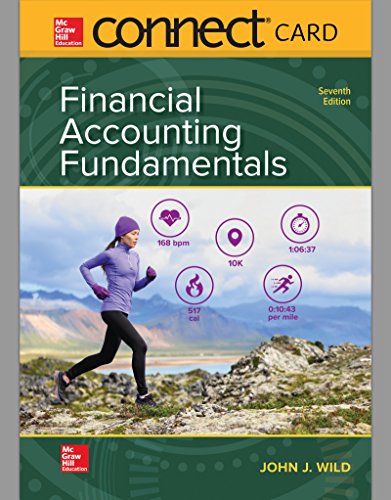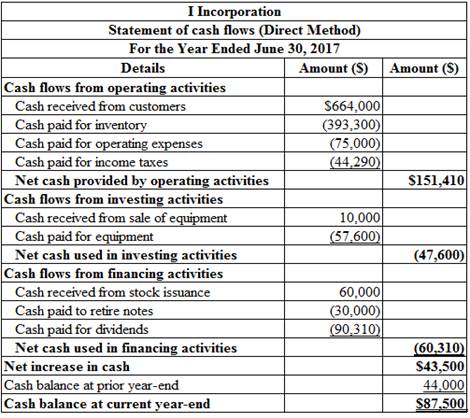
Concept explainers
Prepare the statement of
Explanation of Solution
Statement of cash flows: Statement of cash flows reports all the cash transactions which are responsible for inflow and outflow of cash and result of these transactions is reported as ending balance of cash at the end of reported period. Statement of cash flows includes the changes in cash balance due to operating, investing, and financing activities.
Cash flows from operating activities: Cash flows from operating activity represent the net cash flows from the general operation of the business by comparing the cash receipt and cash payments.
Direct method: The direct method uses the cash basis of accounting for the preparation of the statement of cash flows. It takes into account those revenues and expenses for which cash is either received or paid.
The below table shows the way of calculation of cash flows from operating activities using direct method:
| Cash flows from operating activities (Direct method) |
| Add: Cash receipts. |
| Cash receipt from customer |
| Less: Cash payments: |
| To supplier |
| Interest expense |
| For operating expenses |
| Income tax expenses |
| Net cash provided from or used by operating activities |
Table (1)
Cash flows from investing activities: Cash provided by or used in investing activities is a section of statement of cash flows. It includes the purchase or sale of equipment or land, or marketable securities, which is used for business operations.
| Cash flows from investing activities |
| Add: Proceeds from sale of fixed assets |
| Sale of marketable securities / investments |
| Dividend received |
| Deduct: Purchase of fixed assets/long-lived assets |
| Purchase of marketable securities |
| Net cash provided from or used by investing activities |
Table (2)
Cash flows from financing activities: Cash provided by or used in financing activities is a section of statement of cash flows. It includes raising cash from long-term debt or payment of long-term debt, which is used for business operations.
| Cash flows from financing activities |
| Add: Issuance of common stock |
| Proceeds from borrowings |
| Proceeds from sale of |
| Proceeds from issuance of debt |
| Deduct: Payment of dividend |
| Repayment of debt |
| Interest paid |
| Redemption of debt |
| Purchase of treasury stock |
| Net cash provided from or used by financing activities |
Table (3)
The statement of cash flows for the year ended June 30, 2017:

Table (4)
Working notes:
The amount of cash receipts from customers.
Step 1: Calculate the change in
Step 2: The Calculate the amount of cash receipts from customers.
Calculate the cash payments to suppliers.
Step 1: Calculate the change in inventory.
Step 2: Calculate the change in accounts payable.
Step 3: Calculate the amount of cash payments to suppliers.
Calculate the amount of cash paid for other operating expenses:
Step 1: Calculate the change in prepaid expenses.
Step 2: Calculate the change in wages payable.
Step 3: Calculate the amount of cash paid for other operating expenses.
Calculate the amount of cash paid for income tax expenses:
Step 1: Calculate the change in income taxes payable.
Step 2: Calculate the amount of cash paid for income taxes.
Calculate the cash receipt from sale of equipment:
| Details | Amount ($) | Amount ($) |
| Cost of equipment sold | 48,600 | |
| Less: Accumulated depreciation | (40,600) | |
| Book value of equipment | 8,000 | |
| Gain on sale of equipment | 2,000 | |
| Cash receipt from sale of equipment | $10,000 |
Table (2)
Calculate the amount of cash paid for new equipment:
Calculate the amount of dividend paid:
Want to see more full solutions like this?
Chapter 12 Solutions
Connect Access Card For Financial Accounting Fundamentals
- What will be the expected net income and return on assets for the year of this financial accounting question?arrow_forwardWhat is the present value of the tax shield on debt on these financial accounting question?arrow_forwardSunland Corporation's fiscal year ends on November 30. The following accounts are found in its job order cost accounting system for the first month of the new fiscal year. Other data: 1. 2. 3. 4. On December 1, two jobs were in process: Job No. 154 and Job No. 155. These jobs had combined direct materials costs of $9,165 and combined direct labor costs of $14,100. Overhead was applied at a rate that was 75% of direct labor cost. During December, Job Nos. 156, 157, and 158 were started. On December 31, Job No. 158 was unfinished. This job had charges for direct materials $3,572 and direct labor $4,512, plus manufacturing overhead. All jobs, except for Job No. 158, were completed in December. On December 1, Job No. 153 was in the finished goods warehouse. It had a total cost of $4,700. On December 31, Job No. 157 was the only finished job that was not sold. It had a cost of $3,760. Manufacturing overhead was $1,386 underapplied in December. List the letters (a) through (m) and indicate…arrow_forward
- What is the company's turnover ratio of this financial accounting question?arrow_forwardPlease need help with this accounting questionarrow_forwardCarla Vista Manufacturing Company uses a job order cost system and keeps perpetual inventory records. June 1 Purchased raw materials for $23,600 on account. 8 Raw materials requisitioned by production: $9,440 Direct materials Indirect materials 1,180 Paid factory utilities, $2,478 and repairs for factory equipment, $9,440. 15 25 Incurred $122,000 of factory labor. 25 Time tickets indicated the following: Direct Labor (7,000 hrs x $14 per hr) $98,000 Indirect Labor (3,000 hrs x $8 per hr) 24,000 $122,000 45 25 Applied manufacturing overhead to production based on a predetermined overhead rate of $7 per direct labor hour worked. 28 30 Goods costing $18,020 were completed in the factory and were transferred to finished goods inventory. Goods costing $15,020 were sold for $20,020 on account. Prepare journal entries to record the above transactions during the month of June. (Credit account titles are automatically indented when the amount is entered. Do not indent manually. List all debit…arrow_forward
- PART 2. (22 marks) Mangal Furnishings produce serving trays for the tourist industry in a five-stage process - Cutting & Shaping, Assembly, Sanding, Finishing and Packaging. Upon entering the finishing process, before the trays are stained and polished, a specialized piece of equipment is used to engrave a logo on each tray. After Packaging, the trays are sent to the business warehouse for delivery to customers. The following data relates to the Finishing Process for the month of March during which 3,800 trays valued at $597.90 each were transferred in from the Sanding Process. Other production costs incurred during the month are summarized as follows: Direct Materials Added Direct Manufacturing Wages Hireage cost of specialized logo equipment Manufacturing Overhead $343,380 $830,150 $21,300 $412,100 Process inspection occurs during the process and normally 2% of the trays entering the Finishing process are rejected and sold as scrap to local retailers at $750 each. During the month…arrow_forwardCline Manufacturing Company uses a job order system and maintains perpetual inventory records. Indicate the the appropriate account(s) to be debited and credited for the transactions listed below. (On multiple entries enter answers in alphabetical order.) Transactions 1. Raw materials were purchased on account. 2. Issued a check to Dixon Machine Shop for repair work on factory equipment. 3. Direct materials were requisitioned for Job 280. 4. Factory labor was paid as incurred. 5. Recognized direct labor and indirect labor used. 6. The production department requisitioned 7. indirect materials for use in the factory. Manufacturing overhead was applied to production based on a predetermined overhead rate of $8 per labor hour. 8. Goods that were completed were transferred to finished goods inventory. 9. Goods costing $80,000 were sold for $105,000 on account. 10. Paid for raw materials purchased previously on account. Account(s) Debitedarrow_forwardBased on the screenshot, what is the maximim flow?arrow_forward
- Star Company incurred and paid the following costs for research and development activities: Material used from inventory $ 60,000 Wages and salaries 85,000 Allocation of general and administrative costs 25,000 Depreciation on building housing multiple research and development activities 30,000 Machine purchased for research and development project that has no future alternative uses 35,000 Total $235,000 If Star includes all these costs in research and development expense, including the entire cost of the machine with no alternative future uses, which of the following would be included in the journal entry?arrow_forwardForeign currency translation—Comprehensive income A U.S.-based parent company acquired a European Union–based subsidiary many years ago. The subsidiary is in the service sector, and earns revenues and incurs expenses evenly throughout the year. The following preclosing trial balance includes the subsidiary’s original Euros-based accounting information for the year ended December 31, 2022, immediately prior to closing the company’s nominal accounts into the corresponding balance sheet accounts. It also includes the information converted into $US based on the indicated exchange rates: $US Conversion Weighted- Debits (Credits) Euros Current Average Historical Monetary Assets € 120,000.00 $144,000 $147,600 $156,000 Nonmonetary assets 480,000 576,000 590,400 624,000 Monetary Liabilities (60,000) (72,000) (73,800) (78,000) Nonmonetary liabilities (300,000) (360,000) (369,000) (390,000) Contributed capital (144,000) (172,800) (177,120) (201,600) Retained…arrow_forwardTommys so books on leo July 21 year-end. The company does make eerless crue for Inverses ancage de ke year-end. On June 30, 2007, the Recall cours kolonce à 304,400 Now Reclude she folowing Dute Maker Face Value Tar Maturity Data R Apt C 85,000 90 day July 20 May 15 ya 7,000 July24 Car 10,000 December During Julhe following recom July Modes of $4,300 on Toorak edece 165700 un Vrede cord. The cred card recharge la 26. 20 Recall 24 (a) Journalize the July wonde July designery for ccrued in recevable coming 250 days for exams.com of goods sold edit account titles are automatically indented when amo Account Titles and Explanation Date Debit Credit Textbook and Media List of Accountaarrow_forward

 AccountingAccountingISBN:9781337272094Author:WARREN, Carl S., Reeve, James M., Duchac, Jonathan E.Publisher:Cengage Learning,
AccountingAccountingISBN:9781337272094Author:WARREN, Carl S., Reeve, James M., Duchac, Jonathan E.Publisher:Cengage Learning, Accounting Information SystemsAccountingISBN:9781337619202Author:Hall, James A.Publisher:Cengage Learning,
Accounting Information SystemsAccountingISBN:9781337619202Author:Hall, James A.Publisher:Cengage Learning, Horngren's Cost Accounting: A Managerial Emphasis...AccountingISBN:9780134475585Author:Srikant M. Datar, Madhav V. RajanPublisher:PEARSON
Horngren's Cost Accounting: A Managerial Emphasis...AccountingISBN:9780134475585Author:Srikant M. Datar, Madhav V. RajanPublisher:PEARSON Intermediate AccountingAccountingISBN:9781259722660Author:J. David Spiceland, Mark W. Nelson, Wayne M ThomasPublisher:McGraw-Hill Education
Intermediate AccountingAccountingISBN:9781259722660Author:J. David Spiceland, Mark W. Nelson, Wayne M ThomasPublisher:McGraw-Hill Education Financial and Managerial AccountingAccountingISBN:9781259726705Author:John J Wild, Ken W. Shaw, Barbara Chiappetta Fundamental Accounting PrinciplesPublisher:McGraw-Hill Education
Financial and Managerial AccountingAccountingISBN:9781259726705Author:John J Wild, Ken W. Shaw, Barbara Chiappetta Fundamental Accounting PrinciplesPublisher:McGraw-Hill Education





